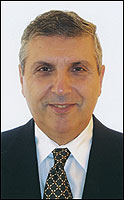Oct 27 2008
Most people would be surprised to learn that the inventor of the advanced hybrid technology used in the Toyota Prius and other vehicles is an American. After all, American car companies have been slow to adopt hybrid technologies.
 Alex J. Severinsky. (Photo courtesy of the Clark School.)
Alex J. Severinsky. (Photo courtesy of the Clark School.)
In fact, he is an engineer and entrepreneur who emigrated to the U.S. from the Soviet Union and launched his inventions at the A. James Clark School of Engineering at the University of Maryland in College Park.
This month, the spotlight will finally shine on Alex J. Severinsky, who designed the Hyperdrive power-amplified internal combustion engine power train. He will be inducted into the Clark School's Innovation Hall of Fame on October 30.
Soon after Severinsky arrived in America as a refugee in 1978 -- in the middle of the national oil crisis of that era -- he recognized a major problem he believed he could help solve.
"I'd just come from bread lines and now I was in gas lines," says Severinsky. He decided to tackle the problem of gasoline consumption.
Severinsky has a Ph.D. in electrical engineering from Moscow's Institute for Precision Measurements in Radioelectronics and Physics. He set about analyzing the Periodic Table, searching for practical alternatives to internal combustion.
He concluded that a fully-electric vehicle would never be practical, but an electric/internal combustion hybrid could work. He took a job in power electronic engineering, where he could immerse himself in the field of high-voltage semiconductors that was crucial to his ideas for a hybrid.
Looking for support for his newly-founded company, Viteq, in 1986, Severinsky connected with the Technology Advancement Program, a venture incubator in the Clark School's Maryland Technology Enterprise Institute (Mtech) that helps regional entrepreneurs build their early-stage companies.
Through Viteq, he developed uninterruptible power supplies for computer systems; later the company was sold to a Texas-based firm. With the help of then Clark School Assistant Dean Herbert Rabin, Severinsky formed yet another company, Power-Assisted Internal Combustion Engine (PAICE), to create a hybrid power train.
Starting in 1992, Severinsky began filing numerous patents for the Hyperdrive power train system. He received additional help from Mtech in arranging a meeting with staff from the National Institutes of Standards and Technology, the U.S. Department of Commerce, and Lockheed Martin.
He made a physical prototype of his technology and, on October 14, 1999, demonstrated the PAICE system in Detroit. Severinsky proved that the system could effectively reduce the gas consumption of a Cadillac Coup de Ville by half in city driving while retaining its driving performance.
Engineers at U.S. and Japanese automakers were interested in Severinsky's invention, but top management resisted. A staff engineer at Toyota later developed the same idea as Severinsky for hybrids. When the Toyota Prius was introduced, Severinsky fought to protect his patent rights. After a protracted legal battle with Toyota, he won the civil case in 2005. (Additional litigation is in progress.)
Severinsky is satisfied with the turn of events.
"I bought my car from Toyota," he said, with a smile. "My wife loves it. It uses several of my inventions."
He credits Toyota for creating an unusual working environment in which in-house competition of ideas is fostered.
With his new company, Fuelcor, he has returned to an old interest that is even more relevant today: using electronics to improve oil production. The idea behind Fuelcor, launched in 2005, is to "make fuel instead of hunting for it" by synthetically manufacturing hydrocarbon compounds from their ultimate products of decomposition -- carbon dioxide and water. Fuelcor is already in the early stages of commercialization on two continents.
"This is the ultimate technology in transportation fuels," he says.
Alex Severinsky will be inducted into the Innovation Hall of Fame at a Clark School ceremony on October 30, 2008. The ceremony will be immediately followed by the Charles and Helen White Symposium on Engineering Innovation, "Intellectual Property: How Well Does the System Protect the Individual Innovator?"